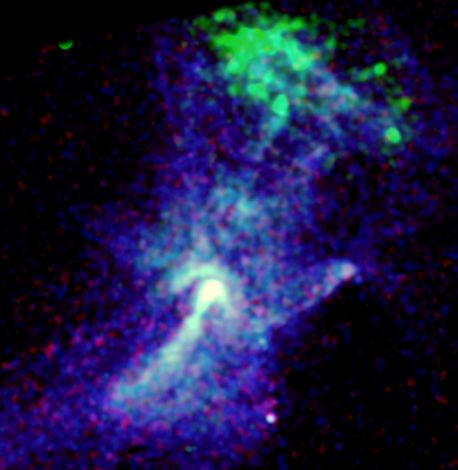
|
Credit & Copyright: B. Gaensler et al.,
MIT,
NASA
Explanation:
A bizarre
stellar
corpse 19,000 light-years from Earth,
pulsar
PSR B1509-58
beckons from the small southern constellation
of Circinus.
Like its cousin at the heart of the Crab nebula,
the Circinus pulsar is a rapidly spinning, magnetized
neutron star.
Seen in this false-color
Chandra Observatory
image, the environment
surrounding this cosmic powerhouse glows in high energy x-rays.
The Circinus
pulsar itself, thought to generate more than
7 quadrillion
volts (7 followed by 15 zeros), lies within the knot of bright
emission near the center of the picture.
Stretching toward the bottom left,
x-ray
emission traces a
jet of particles almost 20 light-years long
that seems to arise from the pulsar's south pole,
while the arc of bright emission
above the central knot is likely a shockwave produced by particles
driven from the pulsar's equator.
Near the top of the picture, lower energy x-ray emission shown in green
is from gas shock-heated to millions of degrees Celsius.
The shocked gas was produced by debris
blasted out from
the stellar explosion that
created the Circinus pulsar.
|
January February March April May June July August September October November December |
| ||||||||||||||||||||||||||||||||||||||||||||||||
NASA Web Site Statements, Warnings, and Disclaimers
NASA Official: Jay Norris. Specific rights apply.
A service of: LHEA at NASA / GSFC
& Michigan Tech. U.
Based on Astronomy Picture
Of the Day
Publications with keywords: neutron star - pulsar
Publications with words: neutron star - pulsar
See also:
- APOD: 2025 September 3 B Cir X1: Jets in the Africa Nebula
- APOD: 2025 August 24 B The Spinning Pulsar of the Crab Nebula
- Supernova Remnant CTA 1
- APOD: 2024 July 23 B The Crab Nebula from Visible to X Ray
- Supernova Cannon Expels Pulsar J0002
- The Spinning Pulsar of the Crab Nebula
- GW200115: Simulation of a Black Hole Merging with a Neutron Star
